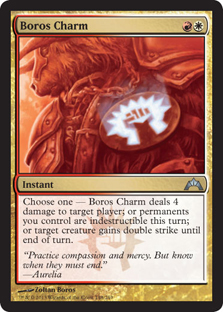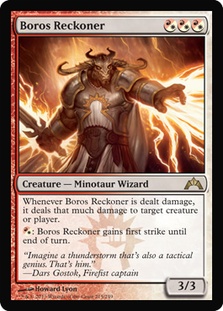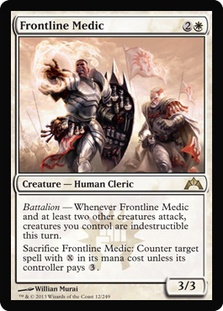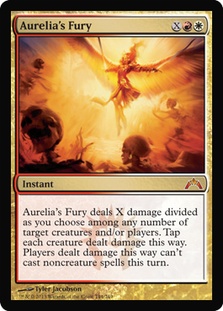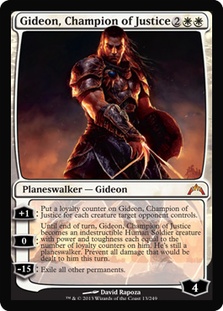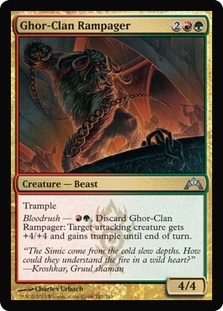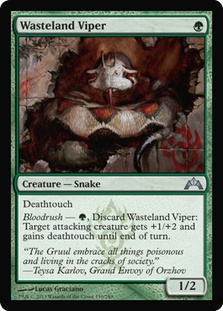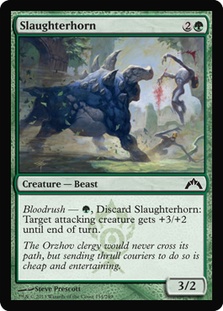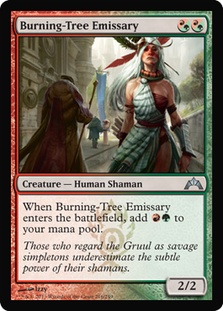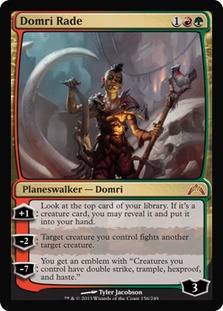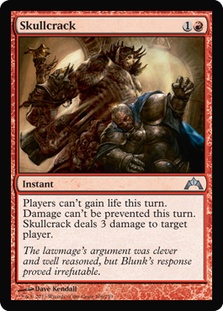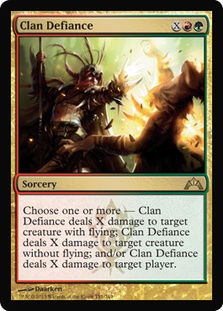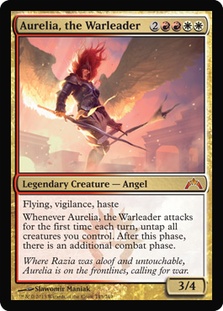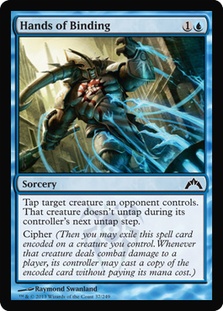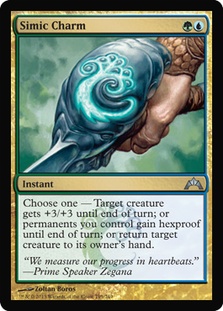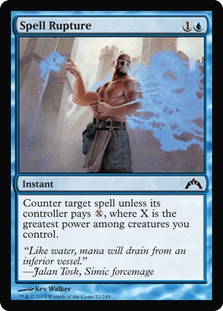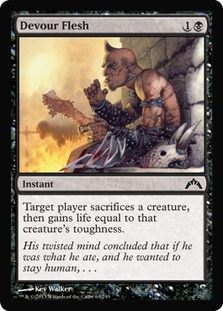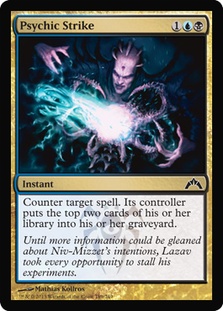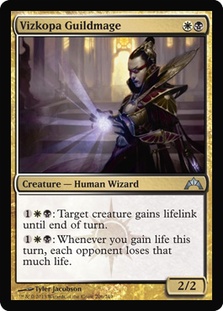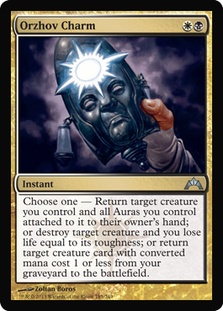“Dear God, I love brewing more than life itself.” –Mark Herberholz
Gatecrash is the order of the day. On Monday we covered updates to existing decks. Today we get down to business… The business of brewing!
When a new set comes out, it can be tempting to try to label every card with some fixed value, but this carries with it a fatal flaw. Magic is dynamic. The utility of a card is contextual and depends on what else is going on. Oh sure, we can evaluate cards based strictly on rate (assuming we take the time to actually understand rate), which is a useful guide, but an awful lot of the most important tournament cards do not have the best rate. They are the right card in the right place at the right time.
To maximize our ability to make winning decks in the new format, we are served by seeking to understand how to use the new cards. This may seem obvious, but most players instead adopt the strategy of trying to figure out which cards are “hot” and which ones to write off.
Let’s start with some aggressive strategies and then work our way over to combo and control. Up first, we have the most talked about guild in Gatecrash, Boros:
Creatures (26)
- 2 Mikaeus, the Lunarch
- 2 Stromkirk Noble
- 4 Champion of the Parish
- 3 Thalia, Guardian of Thraben
- 4 Hellrider
- 4 Silverblade Paladin
- 4 Boros Elite
- 3 Boros Reckoner
Lands (24)
Spells (10)

Boros gains all sorts of new tools, not the least of which is one of the most talked about cards in Gatecrash, Boros Charm. Boros Charm’s virtues are extolled here, but in short, it is a split card with two very powerful options that complement each other fantastically. Generally, making your permanents indestructible is a very powerful option, and when it’s not, doing four damage at instant speed for two mana is. That it has a third mode is just icing on the cake, and when you use it, it’s going to be very strong.
Boros Charm makes Searing Spear probably the default burn spell for most aggressive strategies (or at least the first they look to). We are going to want to hold up two mana, whether to protect against Supreme Verdict and Bonfire or to potentially save our Silverblade Paladin from a removal spell. Having more two-mana instants increases the chances of our being able to use our mana efficiently, as well as hides the fact that we have it (unlike Brimstone Volley, which would telegraph more information, or Pillar of Flame, which might require us to tap mana on our own turn and not hold up Boros Charm).
Boros Charm is so good, however, that it may actually suffer a little from its strength, much the way Path to Exile did and Thragtusk does today. That is to say that the format will evolve around Boros Charm. That doesn’t mean Boros Charm won’t be great; rather, good decks will generally be built with decisions informed by Boros Charm’s existence.
Boros Elite is another exciting new option that greatly increases the strength of Gather the Townsfolk. What used to be merely a Champion of the Parish enabler that could sometimes help out our Hellrider, Gather is now a must-play for white-based Boros decks. Boros Elite makes our best draws even nuttier (as we will sometimes get draws like Champion + Boros Elite + Boros Elite) but does leave us a little more vulnerable to spot removal. Fortunately, spot removal isn’t at its highest, and Boros Charm and Ghor-Clan Rampager incentivize aggressive strategies to play even less.
Boros Reckoner is my favorite of the new three-drops. It’s just a monster versus aggressive decks, as what removal they have will be overworked. More than just a body that does some damage back to our opponent, he also threatens to be a 3/3 first striker, which can dominate the board in a lot of positions… Not to mention letting him trump Thragtusk, an element Boros sorely needed.
Frontline Medic is certainly a respectable card and might be a bit better versus midrange decks (that may actually try to block us). It does have the nice option of messing up our opponent’s Sphinx’s Revelations and Bonfires, so if the format slowed down a little I could easily see wanting to make the move over. He still fights through Thragtusk since he makes all your guys indestructible when attacking. Where Frontline Medic suffers is against aggressive strategies where is often relegated to Trained Armodon duty.
Day 1 the format seems like it will be very aggressive, but it’s even possible that we end up wanting Frontline Medic over Silverblade Paladin rather than Boros Reckoner. Silverblade Paladin is the most powerful of the three on rate, but if enough people are doing two damage or trying to block, that is a possible move to look at.
Aurelia’s Fury is certainly an option maindeck, but it isn’t nearly as strong here as it would be a Naya deck (with its Elves and Farseek) or a blue deck (with its card draw). Still, as a sideboard card, it can give us a number of flexible options ranging from Turnabout to Fireball to Simoon to Orim’s Chant.
Gideon, Champion of Justice is a fine option, giving us powerful Verdict insurance. He also lets us fight token decks and gives us a tool against slightly slower creature decks (which can often be troublesome for Boros). Skullcrack is the other top shelf new sideboard option, and we may want more. But we do have to be careful of playing too many, as the matchups where we’d want them we need to keep our creature count as high as we can. Still, we want people to live in fear…
Boros certainly doesn’t have to be base white, and Monday we covered a possible approach to Boros that stems from Mono-Red Aggro. We will also see some Boros decks that are even whiter than this with even Hellrider not making the cut. There are just so many quality Boros cards available now that we will surely see Boros decks at every point on the spectrum.
Of course, Boros isn’t the only ultra-aggressive guild in Gatecrash. Gruul threatens to change the texture of the format by way of bloodrush, a mechanic that is easy to underestimate because it essentially makes all of those creatures into split cards (which are notoriously difficult to evaluate because of the tricks opportunity cost plays on us). There are a few different ways to build Gruul, but here is a starting point.
Creatures (34)
- 4 Hellrider
- 4 Lightning Mauler
- 4 Flinthoof Boar
- 2 Dryad Militant
- 4 Rakdos Cackler
- 4 Burning-Tree Emissary
- 4 Experiment One
- 4 Ghor-Clan Rampager
- 2 Slaughterhorn
- 2 Wasteland Viper
Lands (22)
Spells (4)
- 4 Rancor

It is not going to take long for most players to realize Ghor-Clan Rampager is just absurdly good. Even when they don’t see it on the surface, playing against it once will drive the message home. It’s not just when they get smashed the first time with its Bloodrush; it’s the next time they try to block and realize, from now on, there are no good blocks.
What a lot of people are going to miss, however, is that there are other good bloodrush creatures. You would never cut Ghor-Clan Rampager for them, as he is just in a league of his own, but Wasteland Viper and Slaughterhorn are both respectable options. What makes them so great is that they are kind of like removal spells (when used as offensive tricks), but instead of having a defensive mode (like Giant Growth can sometimes…) they can double as additional threats.
Wasteland Viper is deceptively good at being played as a creature, often trading up (and that is the back-up plan!). Typhoid Rats was borderline playable, and the Viper’s second point of health makes him better against Elves, triggers your Experiment One, and lets him live through a Thragtusk if he attacks and you have Ghor-Clan Rampager. His other mode is just as good but is often good in different spots. He will usually let you trade just one mana for something worth more than one mana, such as Loxodon Smiter foolish enough to block your Flinthoof Boar.
Slaughterhorn isn’t as inherently strong of a card as Wasteland Viper but is a bit of hedge against creature-light opponents. How can we tell that Slaughterhorn is a weaker card? While a 1/2 deathtouch creature is at least in the discussion to play on its own, a 3/2 for three is miles from playable and a 3/2 for two is barely playable (if that). Slaughterhorn does have a slightly better bloodrush ability, but it’s nowhere near as big a gap as there is in their bodies. Wasteland Viper also opens up some options that Slaughterhorn doesn’t (such as the fantastic interaction with trample courtesy of Rampager).
So why use Slaughterhorn at all? Paying extra for something is not as expensive as it looks when it is an option that you are only doing some percentage of the time. A 1/2 deathtouch for one may be a better deal, but sometimes when we don’t want a pump spell we just want something that can deal some damage. Slaughterhorn does have bigger numbers. Drawing two Vipers against a control deck really sucks, whereas the Slaughterhorn is still a semi-legitimate threat.
Burning-Tree Emissary is a pivotable card slot to decide on, and it is far from clear that he’s your man (er, tree?). We can also move towards Strangleroot Geist or Ash Zealot. Either would be stronger than any of our two-drops, but they each bring us worse mana and push us down a certain path. We may want to be more “green fatties” or “red aggro,” but I want to try the explosive new card first.
Stromkirk Noble is also an option, but he gets worse when you are using lots of bloodrush instead of burn. If all you have is Ghor-Clan, no problem since he’s actually awesome there. However, Slaughterhorn and Wasteland Viper are poor ways to force a Noble through, and he doesn’t power up your Experiment One. We aren’t short on Jackal Pups anyway.
I’d like to think this build is too fast for Domri Rade maindeck; however, he is a potent sideboard card (and we’ll be hitting half the time or more after board). Skullcrack is certainly an option, of course, but some of the more interesting sideboard cards are the ones that let us get a little bigger. For instance, Huntmaster of the Fells is a very exciting sideboard card for winning creature wars. It is totally reasonable to sideboard land, and in our case, Cavern of Souls and Kessig Wolf Run are actually super nice options to have.
Remember, if we are going to play Gruul, it has to be more than just a bad something else. Why it is better than Boros? Rakdos? There are two primary approaches: either we hit harder fast (with cards like Experiment One and bloodrush making blocking a pain) or we go bigger with mana creatures and green fatties. I’m not sure yet what advantage the fatty version of Gruul is supposed to have over Naya, but I guess its mana is a little better.
Creatures (30)
- 1 Borderland Ranger
- 4 Arbor Elf
- 4 Strangleroot Geist
- 4 Huntmaster of the Fells
- 2 Wolfir Silverheart
- 2 Thundermaw Hellkite
- 4 Flinthoof Boar
- 4 Experiment One
- 4 Ghor-Clan Rampager
- 1 Wasteland Viper
Planeswalkers (4)
Lands (24)

If we are trying to midrange it up a bit, Domri Rade starts to look real enticing. We can also take advantage of quality cards like Strangleroot Geist and Huntmaster to try to card quality people out. It might be too greedy to play no removal (aside from planeswalkers and bloodrush). Brimstone Volley, Devil’s Play, Searing Spear, and Pillar of Flame are all obvious options, but I’d also consider Flames of the Firebrand and a new one, Clan Defiance. Clan Defiance is a bit slow, but if we ever get to a format where opponents with fliers and non-fliers is common, this one could get there (particularly if they have relatively low toughness). Being able to hit a Restoration Angel, an Augur of Bolas, and Fireblast our opponent is not insignificant.
Of course, Boros and Gruul are going to be blended together in many ways. There will surely be Big Naya decks that look nothing like these decks, but there will also be Zoo decks much closer to the best 20 cards from each of these decks and the best 20 cards from G/W.
Creatures (24)
- 4 Avacyn's Pilgrim
- 4 Silverblade Paladin
- 4 Dryad Militant
- 4 Loxodon Smiter
- 4 Experiment One
- 4 Ghor-Clan Rampager
Lands (23)
Spells (13)

As was the case last time Zoo was a real thing in Standard, the price you pay is a dubious mana base. In exchange, you are talking about a lot of really big bodies and hyper-efficient tricks at low mana costa. What is your opponent supposed to do when you attack with two mana open (AKA every turn)? Ghor-Clan Rampager and Boros Charm even combine to form a lethal turn 4 (letting your Smiter attack for 16 damage himself).
The double strike element of this deck is not to be underestimated. Silverblade Paladin and Boros Charm give us eight ways to double strike, and Rancor, Ghor-Clan Rampager, and Selesnya Charm give us nine pumps. Loxodon Smiter and Experiment One are both very large and are often both 4/4s by the time we want to go for the jugular.
An important note about Experiment One: when he is 4/4, there is a real desire to remove two counters and regenerate when he is against another 4/4. This doesn’t work out well. There is no window to remove counters after damage has been dealt, but before he receives it (AKA damage on the stack). Players who have only been playing for the past four years will not feel this, but ten-year veterans may be surprised at how strong of a desire there is to do this despite how long it’s been since M10.
Is Experiment One really supposed to be the first creature in every green deck? He is really good and is definitely in the Top 5 cards in the set.
The double strike theme can be carried even further, of course:
Creatures (25)
- 4 Arbor Elf
- 4 Avacyn's Pilgrim
- 4 Silverblade Paladin
- 4 Thundermaw Hellkite
- 3 Aurelia, the Warleader
- 4 Ghor-Clan Rampager
- 2 Wrecking Ogre
Lands (24)
Spells (10)
- 2 Rancor
- 4 Farseek
- 4 Boros Charm

This is probably going too far, but if people don’t play removal, you can set up some 20-point turns pretty easily. Wrecking Ogre can be a double strike enabler, letting us go play Thundermaw and deal five then bloodrush and deal sixteen for the kill. However, he can also be a threat when we need (killing in two hits with Rancor). Ajani, Caller of the Pride is also an option, but I’m not sure it’s actually as good for us if we are playing this much ramp. Aurelia, the Warleader with double strike is basically quad strike, and flying is nice, so there is that. This is another card that just wins if we play it after a Thundermaw Hellkite (another natural 21).
Switching back to our main man, the Experiment One, he is also going to be at the center of a new archetype, evolve aggro:
Creatures (23)
- 4 Avacyn's Pilgrim
- 4 Geist of Saint Traft
- 4 Loxodon Smiter
- 4 Cloudfin Raptor
- 4 Experiment One
- 3 Shambleshark
Lands (23)
Spells (14)

Evolve decks can certainly go more “all-in” if they want, playing cards like Gyre Sage or Fathom Mage or Elusive Krasis. They can also go more of a Zameck Guildmage route, which has super-strong synergy with evolve (though that does take us in a more midrange direction than this build, which is all tempo all the time). We’ll explore more of that sort of direction Friday.
Just as Experiment One is in a tier above Cloudfin Raptor, so too is the Raptor above Shambleshark (who is far from vital).
Having a diverse mix of tempo plays is really important, which plays well with the Geist of Saint Traft sort of tempo strategies. Hands of Binding is a tricky one, as it is a very different sort of card than we have had access to. I think people are underestimating it right now because no one has a good sense of cipher’s strength. It definitely seems hot for Limited, but it could also work well for Constructed. You might need more of an Invisible Stalker type strategy, but there is a lot of reason to believe that most people won’t have an overwhelming amount of removal. Besides, even if you just connect once, you have already paid for the card by getting a full Blinding Beam out of it.
Simic Charm is no surprise, though I do think people slightly overrate it. People like abilities they understand, but its modes are all basically tempo plays, so paying two mana for them instead of one is a little less good than people realize. Still, it’s a solid card.
Spell Rupture hasn’t gotten a ton of press but is just a solid role-player for creature-heavy decks that need a counterspell. That it costs two is particularly important in a world where we want to hold up mana for Selesnya Charm, Simic Charm, and so on (as opposed to Dissipate).
I’m still toying around with some cipher-based strategies and hope to have more figured out by Friday. Here is one sketch I am starting with, but I question how to make it work against cards like Gravecrawler and Geralf’s Messenger.
Creatures (12)
Planeswalkers (3)
Lands (22)
Spells (23)

The deck is probably real loose, but Nightveil Specter seems hot. Granted, we don’t have all the colors here, so he’s not as good as he would be somewhere that can fix easier; however, he does eventually draw you land from their deck. I am definitely going to be looking at this guy in some three- and four-color specials.
Speaking of…
How about the finest of all three-color specials, Grixis?
Creatures (5)
Planeswalkers (4)
Lands (27)
Spells (24)

While I do not expect Grixis to become mainstream given the existence of Sphinx’s Revelation, it is an interesting rogue angle to attack the format with and gives us access to Olivia, Pillar of Flame, and Devour Flesh while still having blue’s card draw. Devour Flesh is an important new weapon for Grixis and combines with Liliana and Barter in Blood to form a powerful anti-creature plan, particularly with Pillar of Flame helping and great sideboard options like Curse of Death’s Hold and Magmaquake.
Most of our early mana needs are red and black, so it is possible we want to move away from Dissipate and use Psychic Strike only, shifting the mana around a bit. We probably still want Jace 5 as a kill card, but his double blue doesn’t come until later anyway.
Loading up on Slaughter Games is important for fighting Sphinx’s Revelation decks, but we also get a lot of mileage out of cards like Vampire Nighthawk (helping against aggression in a new way).
There are more brews than time in the day, but I will be exploring even more come Friday. Before we close for the day, I want to hit a bunch of combo concepts. While many of the above aggro decks are ready for tournament play, most of these combo sketches are starting points. Most of them won’t pan out, but it only takes one to win the tournament.
Creatures (4)
Lands (25)
Spells (31)

Vizkopa Guildmage + Exquisite Blood form a game-winning mondo-combo. Devour Flesh appears as the removal of choice again. Blind Obedience is just sweet, helps against haste and burn, and gives us a reliable way to trigger the first point of damage for the combo.
Orzhov Keyrune is just a solid card but is more appropriate with our focus on B/W. It also combos well with sweepers and Vizkopa Guildmage. Psychic Strike is chosen again for ease of casting.
Creatures (26)
- 4 Elvish Visionary
- 4 Elvish Archdruid
- 4 Arbor Elf
- 4 Evil Twin
- 1 Havengul Lich
- 1 Jarad, Golgari Lich Lord
- 4 Deathrite Shaman
- 4 Biovisionary
Lands (21)
Spells (13)

Now that is a new kind of Elf Combo deck! The primary goal is to speed through the deck and try to set up Biovisionary + Infinite Reflection for the instant win. You can just do it the hard way, with Evil Twin helping us get up to four, or we can find the Immortal Servitude or Havengul Lich to try to hit all the Visionaries out of our graveyard. Finally, we can just play an Elf back-up game, with Jarad potentially helping finish the job.
Creatures (14)
Lands (22)
Spells (26)

Boros Reckoner gives us Stuffy Dolls five through eight, meaning we can have some real fun with cards that do thirteen damage. Into the Maw of Hell is an option, but Harvest Pyre, Blasphemous Act, and Magmaquake are probably enough (and just stronger cards on their own). Harvest Pyre in particular is really interesting, letting us kill people at instant speed out of nowhere.
Ok, I’m out for today, but I will pick back up on Friday with Reanimator (both Human and not), Omniscience + Enter the Infinite, Whispering Madness (both combo and not), W/B Aggro, BUG Control, Zegana, and much more! If you have any requests or cards you just want to get a second opinion on, let me know in the comments. We’ve already had multiple days! Time to determine the Top 10 cards in the set…
See you Friday!
Patrick Chapin
“The Innovator”
 |
The first rule of Dimir Guild is you do not talk about Dimir Guild. The second rule of Dimir Guild is you do NOT talk about Dimir Guild. My official response? Izzet and proud… |

